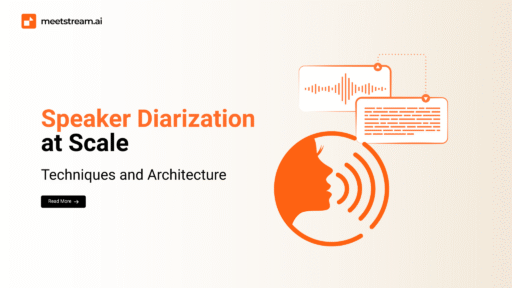In the age of AI-powered collaboration and digital transformation, the ability to determine “who said what” during audio conversations has become crucial.
This process, known as speaker diarization, enables systems to segment speech and assign segments to individual speakers, making unstructured audio data more organized, searchable, and actionable.
Whether it’s an AI meeting assistant summarizing calls, a transcription service attributing dialogue, or analytics software extracting insights from customer interactions, diarization forms the foundation for intelligent voice-based systems.
Unlike basic speech recognition, which converts speech into text, diarization adds a semantic layer by labeling speakers over time.
As remote work, virtual meetings, and customer service voice channels grow, accurate diarization is increasingly vital.
Platforms like MeetStream.ai are designed to support this need at scale, offering robust, real-time speaker diarization integrated with platforms such as Zoom, Google Meet, and Microsoft Teams.
This article explores the core techniques behind diarization, how it scales effectively, and how MeetStream delivers production-ready diarization capabilities.
Understanding Speaker Diarization and Its Use Cases
At its core, speaker diarization is the task of partitioning an audio recording and associating each segment with a unique speaker.
In simpler terms, it answers the question: “Who spoke when?”
This enables clear, speaker-labeled transcripts that help identify participation, decisions, and follow-ups in multi-party conversations.
Key Use Cases
- Meeting transcription: Speaker-attributed transcripts in team discussions, webinars, and interviews enhance clarity and accountability.
- Call center analytics: Diarization helps distinguish between agents and customers for better quality assurance, training, and compliance monitoring.
- Podcast and media editing: Facilitates quote extraction, indexing, and editing in interviews or multi-voice content.
- Legal and financial record-keeping: Provides traceable, speaker-specific documentation for regulatory compliance and audit trails.
Challenges in Real-World Scenarios
Real-world diarization must overcome several challenges:
- Overlapping speech: Conversations often involve interruptions or simultaneous talk.
- Poor audio quality: Noisy environments, low-fidelity recordings, or bad microphones reduce performance.
- Speaker variability: Accents, language switching, and unfamiliar voices can confuse models.
Robust diarization requires systems that can adapt across these variables without compromising accuracy or speed.
Core Techniques Behind Speaker Diarization
Modern speaker diarization combines signal processing, statistical modeling, and deep learning to deliver high-performance results.
Classical Approaches
Earlier methods relied heavily on clustering techniques.
Audio is split into segments, converted into speaker embeddings (i.e., numerical representations of voice traits), and grouped via algorithms like k-means or agglomerative hierarchical clustering.
These unsupervised techniques were foundational but had limitations in noisy or overlapping environments.
Deep Learning Innovations
Today, deep neural networks such as x-vectors and ECAPA-TDNN offer more reliable speaker embeddings.
Trained on vast, multilingual speech datasets, these models capture identity-rich voice features and generalize well across languages and environments.
Newer architectures—like transformer-based diarization models—leverage attention mechanisms to understand long-term dependencies in audio.
These are particularly effective in capturing conversational context in complex dialogues.
A Typical Diarization Pipeline
- Voice Activity Detection (VAD): Filters out silence and background noise.
- Segmentation: Divides audio into speaker-agnostic chunks.
- Embedding Extraction: Generates speaker embeddings for each segment.
- Clustering: Groups similar embeddings to identify speakers.
Hybrid Diarization-Recognition Models
In enterprise settings, diarization is often enhanced with speaker recognition, where speaker profiles are pre-enrolled.
These hybrid models improve consistency by mapping voice segments to known individuals, making them ideal for recurring meetings or frequent speakers.
How MeetStream Performs Speaker Diarization at Scale
At MeetStream.ai, speaker diarization is embedded as a native capability within its real-time AI meeting infrastructure.
Key Features
- Real-time and post-call diarization: Supports live speaker labeling during meetings and refined diarization afterward.
- Platform compatibility: Works across Zoom, Google Meet, and Microsoft Teams.
- Modular architecture: Each component—VAD, segmentation, embedding extraction, clustering—is containerized and horizontally scalable.
Developer Access
- REST APIs & Webhooks: Developers can access diarization metadata, including timestamps, speaker labels, and confidence scores.
- Integration-ready: Ideal for downstream use cases such as smart summaries, CRM updates, searchable archives, or compliance logging.
MeetStream makes it easy to integrate speaker-aware features into third-party applications without building diarization from scratch.
Scalable Architecture for High-Volume Speaker Diarization
Scaling diarization involves challenges like concurrency, latency, and resource efficiency. MeetStream solves these through a purpose-built, distributed microservices architecture.
Key Components
- Audio Ingestion Layer: Handles real-time and batch inputs with fault tolerance and low latency.
- Preprocessing Engine: Applies noise reduction, normalization, and silence trimming to improve downstream accuracy.
- Embedding & Clustering Core: GPU-accelerated processing extracts embeddings and performs real-time or batch clustering.
Scalability
- Horizontal scaling with Kubernetes: Allows individual components to scale independently based on usage.
- Memory optimization & caching: Prevents redundant computation, especially for long or recurring conversations.
- Cloud-agnostic deployment: Deploy on AWS, Azure, GCP, or private cloud to meet enterprise compliance and governance standards.
Challenges and Considerations When Scaling Diarization
Scaling speaker diarization in production settings introduces unique technical and operational hurdles.
1. Latency vs. Accuracy Trade-Off
Real-time diarization demands speed, but faster models often sacrifice accuracy. MeetStream mitigates this with a dual-stage system:
- Stage 1: Lightweight model for live tagging
- Stage 2: Accurate post-processing for final transcripts
2. Speaker Overlap and Crosstalk
Overlapping speech is common in fast-paced discussions. MeetStream uses overlap-aware diarization and source separation to isolate voices and assign labels accurately.
3. Language & Accent Diversity
Multilingual environments and regional accents can challenge even robust models. MeetStream’s training data includes diverse speakers and accents, ensuring broader generalization.
4. Transcription Synchronization
Synchronizing diarization with ASR (automatic speech recognition) ensures that timestamps and speaker tags remain aligned. MeetStream applies time-drift correction to maintain transcript coherence.
5. Data Privacy and Compliance
Handling voice data involves privacy-sensitive concerns. MeetStream offers:
- Custom retention policies
- On-premise deployment options
- GDPR, HIPAA, and CCPA compliance
- Enterprise-grade encryption and access control
Conclusion
Speaker diarization is not just a supporting feature—it is a pivotal component of modern voice-based AI systems.
From remote work and customer engagement to legal and media workflows, diarization unlocks the potential of spoken conversations by attributing speech to individuals with precision.
With scalable, real-time capabilities, MeetStream.ai empowers developers and organizations to build diarization-aware products that go beyond transcription—enabling true conversational intelligence.





